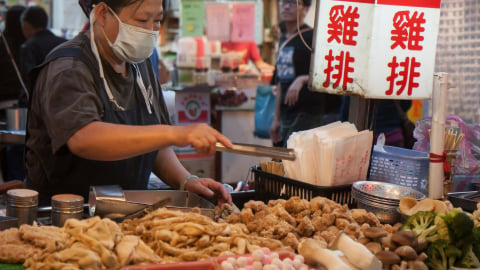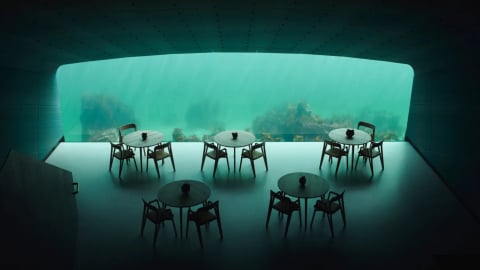Where to unlock memory
Stepping through the door of Saigon CCCP, one feels as if one has just left the noisy city and wandered into a small house somewhere in the middle of faraway Russia. Warm yellow light spreads on the wall covered with pale floral paper, where framed pictures and photos of the Soviet era are hung not in a certain pattern, but according to the memories of the person who arranged them.



At each corner of the table, a fabric-shaded lamp cast a warm yellow light on the antique tablecloth, neatly arranged cutlery and glasses. The light slid across the dark wooden chair, touching the stationary wheels at the foot of the chair. The whole room felt as if time had stopped, with only warmth, light and a little memory lingering in the space.
On the shelf, a few bottles of wine, a blue enamel plate, and a tiny Matryoshka doll were placed side by side, like a memory gathered from many years. Next to it, a corner of the first floor was covered with red maple leaves, recalling a winter long ago.


A red-carpeted staircase leads to the second floor, where the two areas are connected by a small corridor like a bridge over the red-leafed valley below. Here, the tables are placed closer together, the warmth spreads through the distance between people, giving the image of a small, close-knit community, like the spirit of the Soviet Union.



Cozy space on the second floor of the restaurant
Going up to the third floor, the space slowly shrinks, the yellow light covers the walls and flows slowly on the red and yellow checkered curtains. There are no windows, only the warmth gathered between the four walls, making the room seem to shrink in its breath - a secret place where people can tell each other private stories.



The third floor space is closed with flower walls and warm yellow light that does not come through the windows.
Keeping the memory of the Soviet Union alive in Saigon
The story of CCCP began 20 years ago, when the first restaurant was opened by Ukrainian chef Svetlana Nguyen on Ngoc Khanh Street, Hanoi in 2005. Sharing a deep connection with the land of the White Birch, Nguyen Duy Thanh's family has also had many years of attachment to Russia as his parents studied and worked in Russia, and he himself lived in Moscow for more than 10 years. Therefore, after meeting his wife, Suzan, daughter of Svetlana Nguyen, the couple decided to bring that spirit to the South, opening a restaurant to share the belief that Soviet culture can still live in modern life.



Soviet-inspired objects, souvenirs, and pictures
He said that the first days of opening the restaurant were also difficult, many people gave advice, even prevented, because they had never seen the Soviet restaurant model appear in Saigon. But he believed that the real taste itself would tell the story. Seven years have passed, the restaurant still stands strong not only because of the delicious food, but also because of the emotional atmosphere, where people who studied in Russia find a part of their memories, and young Vietnamese people are curious to explore a distant yet strangely close culture.
Every corner of the restaurant is personally arranged and taken care of by Mr. Thanh and his wife, from choosing the tablecloth patterns, to changing the shape of the napkin trays on each table: tea pots, hedgehogs, butterflies... Mr. Thanh's hands have experienced the simplest tasks: cleaning, washing dishes, cooking... before taking on the media part, telling the story of CCCP through each short film, each flavor, or simply each detail bearing the Russian mark in the restaurant space, so that diners can fully feel the spirit of this place.



The shop has items brought back from Russia such as tablecloths, fabric lamps, tea pots, plates... typical
“CCCP Saigon is not simply a restaurant, but a place for people to remember and tell stories,” Mr. Thanh said, his eyes looking at the wall hanging with a picture of Red Square. “Every person who has lived, studied, and dreamed in Russia has their own story and we simply keep that story in the middle of Saigon.”
Soviet flavor melts on the table
On the table, the smell of butter melting gently on the black bread, mixed with the warm aroma of beetroot soup and the smoke of grilled meat, entwined with the chatter of the diners. The slightly sour and slightly salty taste of the black bread opened the meal with a simple rhythm, the rich aroma wafting up like a warm greeting before taking the taste buds into the depths.

Typical Soviet dishes are served at the restaurant.

Black bread with Soviet butter

Appetizer salad
Crispy vegetable salad, mixed with mayonnaise, brings the taste to a new, light and balanced level. The aroma of Borsch (red beet) soup spreads across the table, the distinctive red color of the beet, spoonfuls of handmade Smetana (milk curd) melts into the broth, leaving a light and fatty taste, reminiscent of winters in a warm kitchen with typical Soviet soup.
While the warm taste of the soup lingered on the tongue, the pelmeni appeared, the thick, white, soft skin embracing the meat filling. In the middle of the table was a piece of thinly sliced salted fat served with garlic and homemade yellow mustard, the fatty and salty flavors intertwined with the sharpness of the garlic, the flavor of simple conversations over a glass of vodka.

Sliced lard served with garlic and yellow mustard

Pelmeni - Russian dumplings

Borsch (beetroot) soup with Smetana (curd) - a traditional dish of the Soviet Union
The aroma of shashlik wafted in from the shashlik tray, pieces of imported spiced lamb and pork grilled over charcoal, the softness and natural sweetness bursting out in each cut. Crispy chebureki (a type of fried pastry), pulled cheese, suddenly making the space echo with a bit of the noise of the old Soviet street market, simple dishes but warm with the imprint of everyday life.

Shashilik Tray - a symbol of Soviet picnics, consisting of grilled lamb and pork served with pickled vegetables
As the party came to a close, the cakes appeared like a gentle note at the end of the symphony. Napoleon cake with a crispy thousand-layer crust, surrounded by a layer of light vanilla cream, is considered the “emperor’s cake” in Russian cuisine. The chocolate aroma from the Praga cake covered with a layer of shiny black ganache continued, spreading in the mouth the faint taste of rum and apricot jam, both deep and warm. A pot of black tea with lemon was poured, the light aroma serving as a background for that sweet aftertaste, ending the meal in a peaceful feeling like sitting in the middle of grandma’s warm kitchen in the middle of a Russian winter.



The thousand-pound Napoleon cake is currently being "hunted" by many people.
“We try to keep the original recipe, from baking, cooking soup to mixing sauces, because Russian cuisine is only right when you feel it is simple and warm,” Thanh shared. All ingredients are carefully selected, many types of flour and spices must be imported from Europe, but he does not follow the “fine dining” direction. For him, Russian cuisine does not need to be luxurious, just genuine, like the people who create it.
When the lights in the restaurant dim, Russian melodies begin to play. Every Tuesday evening, the voice of Oksana - a Russian woman with a deep love for traditional classical music - resonates in the cozy space. Familiar Soviet-era songs seem to touch distant memories, making diners feel as if they are sitting in a small restaurant in the middle of Moscow. On Thursday evenings, the sounds of guitar and saxophone blend together, performed live by two Russian artists. The melodies float through the space, gently passing through the smell of hot soup and the taste of pastries, evoking a gentle nostalgia, as if someone had just opened an old memory.

Oksana - Russian traditional music singer interacts with diners at the restaurant

Diners are given musical instruments to join in the melody, creating a harmony in a cozy, intimate space.
Amidst the interwoven conversations that echoed from every corner of the restaurant, the smell of beetroot soup, baked goods and coffee mixed in the air, making people feel like they were somewhere in the middle of winter in Moscow. But instead of the numbing cold, this place radiated warmth from wood, light, and a sense of familiarity created by the meticulousness that the owner took care of and put into every detail. The restaurant does not try to recreate a “showcase” Russia, but rather the Russia of memories - where everything is kept by hand and memories have existed for decades.

 EN
EN



































